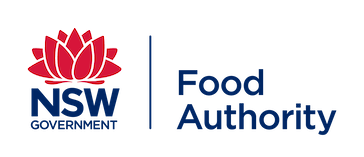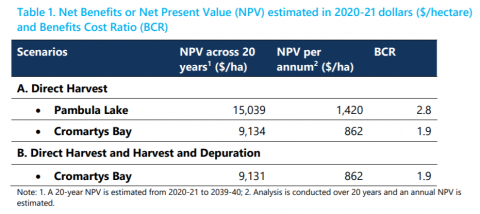Real-time sensors for shellfish harvest area management
The 2021-2024 Food Agility CRC Transforming Australian Shellfish Production Project is supporting the adoption and use of data (salinity, temperature and water height) from real-time sensors in fifteen NSW oyster producing estuaries and one developing aquaculture zone in Western Australia.
Application of this technology is being developed as part of a collaboration between the Food Agility Cooperative Research Centre, University of Technology Sydney (UTS) and the NSW DPI (Aquaculture Research and Biosecurity and Food Safety), NSW Farmers Association and the Western Australia Agriculture Authority, along with NSW and WA oyster farmers.
The project has demonstrated proof of concept of the potential to use salinity-based management plans in lieu of traditional rainfall-based plans in oyster growing harvest areas. The project also includes the refinement of molecular based tools to track potential pollution sources (human, bird, cattle) in biological samples. Estuary specific reports are being developed for each participating location and include modelling of sensor data relative to findings of pollution source tracking and oyster growth data. Further information can be found on the Food Agility CRC website.
Key findings
A Cost Benefit Analysis (CBA) has estimated the returns on investments for salinity-based management for three case study harvest areas Pambula Lake, Cromartys Bay (Port Stephens) and Wapengo Front Lake.
Table 1 presents estimates of the net benefits (NPV per hectare and harvest area) and return on investment (Benefits Cost Ratio) from investment in this technology in both drought and above average rainfall periods.
Table 1 CBA results estimated in 2020-21 dollars ($/hectare)
|
Catchment area |
Drought1 |
Above average rainfall2 |
||||
|
Annualised Net Present Value |
Benefit Cost Ratio |
Annualised Net Present Value |
Benefit Cost Ratio |
|||
|
Returns per hectare ($/ha) |
Returns to harvest areas ($/area) |
Returns per hectare ($/ha) |
Returns to harvest areas ($/area) |
|||
|
Pambula Lake |
1,923 |
116,679 |
2.12 |
1,562 |
108,353 |
2.14 |
|
Cromartys Bay3 |
1,121 |
15,923 |
1.52 |
549 |
9,375 |
1.45 |
|
Wapengo Front Lake
|
1,416 |
37,774 |
1.88 |
1,784 |
47,611 |
1.97 |
Note: 1. Drought periods are 2016-17 to 2019-20 for Pambula Lake, 2017-18 to 2019-20 for Cromartys Bay and 2018-19 to 2019-20 for Wapengo Front Lake; 2. Above average rainfall compared to historical records occurred in 2020-21 to 2021-22 for all case study areas (BOM 2023); 3. Harvest and depuration is also used in Cromartys Bay, however, it was found to have no significant impact on CBA results in NSW DPI (2021) and so is not assessed in this CBA.
A range of social and environmental benefits have resulted from the volume of real-time data recorded by sensors. Increasing estuary data improves:
- the condition of estuaries (i.e., pollution sources) by supporting remediation activities and enhancing knowledge of contamination events
- public awareness of estuary condition and environmental impacts
- food safety that supports the production of safer food in Australia for the domestic and export market, research into food safety
- support for business and stock management, increasing returns to producers and industry expansion into the future.
More information
- Read the findings and results in full by downloading the Drought & Above Average Rainfall Impacts on the Net Returns to NSW Oyster Production – Using Real-Time Sensors
- View videos on the Food Agility CRC project at: Food Agility CRC – Cooperative Research Centre customer story
The 2017-2020 Food Agility CRC oyster industry transformation project used data from real-time sensors in 13 NSW oyster producing estuaries, measuring salinity, temperature and water height in shellfish harvest areas.
Salinity data from this project can be used to refine harvest area management plans, potentially increasing future harvest opportunities. Project data will also support the development of models for harmful algal bloom and oyster mortality events to assist in refining farm management practices for industry.
Oyster producers at Pambula Lake and Cromartys Bay (Port Stephens) were early adopters of salinity-based harvest area management plans using real-time sensor data. An independent economic assessment by the NSW Department of Primary Industries (DPI)on the use of sensors in these areas reported a positive economic impact for both harvest areas, due to increased harvest opportunities.
The oyster industry transformation project is a collaboration between the Food Agility CRC, NSW DPI Aquaculture Research, NSW Food Authority Shellfish Program, University of Technology Sydney (UTS), NSW Hunter Local Land Services (LLS), The Yield and NSW oyster farmers.
Key findings
The economic assessment found a positive annual net benefit (profit after all operational costs, including sensor installation and maintenance) in both case study harvest areas:
- Pambula Lake: Net present value (NPV) of $1,420 per hectare per year
- Cromartys Bay: NPV of $862 per hectare per year
Based on the current harvest area, this equates to an annual net benefit of $95,736 in Pambula Lake (67.42 hectares) and $15,344 in Cromartys Bay (17.8 hectares).
Results showed the total cost of a sensor may be recovered in the first year of operation in Pambula Lake (at a sensor cost of $429 per business) and the second year in Cromartys Bay (at a sensor cost of $1,714 per business).
Sensitivity analysis within the report showed a positive economic benefit if there was damage to the real-time sensor that required a replacement within the second year of its operation. The report also considered changes in interest discount rates or farm gate price for shellfish, which all showed positive NPVs.
The benefits of using real-time sensors are transferable to the wider shellfish industry. Apart from increase in harvest opportunities, the report showed there were other likely benefits for adopting real-time sensors in shellfish growing areas:
- Ongoing environmental monitoring, like prediction of harmful algal blooms and water quality that is critical during floods, bushfires and other emergencies
- Potential reduction in farmer stress associated with unnecessary closure of harvest areas
- Data collected from sensors inform oyster research
- Improved planning of business operations
- Improved cash flow from more contiguous harvest windows
- Reduced costs and risk of mortality from holding stock due to delayed harvest.
More information
Read the findings and results in full by downloading the Net Returns of Real-Time Sensors and Salinity-Based Management Plans in NSW Oyster Production report.
For a summary of the findings download a copy of the Net Returns of Real-Time Sensors and Salinity-Based Management Plans in NSW Oyster Production factsheet.
View videos on the Food Agility CRC project at: Food Agility CRC – Cooperative Research Centre customer story

